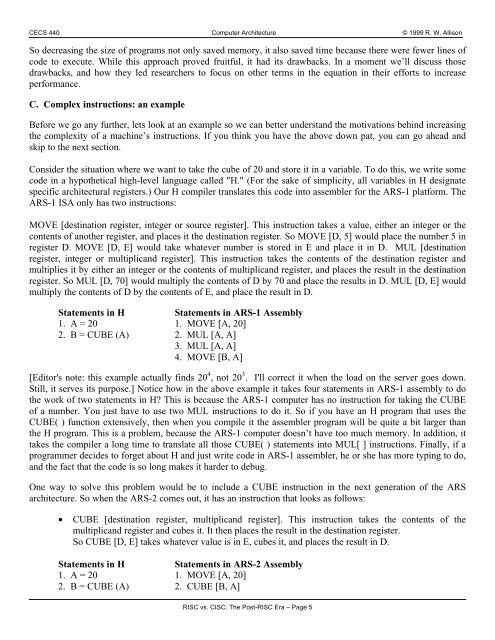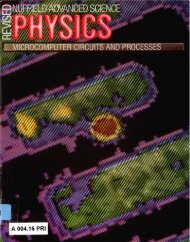RISC vs. CISC
RISC vs. CISC
RISC vs. CISC
Create successful ePaper yourself
Turn your PDF publications into a flip-book with our unique Google optimized e-Paper software.
CECS 440 Computer Architecture © 1999 R. W. Allison<br />
So decreasing the size of programs not only saved memory, it also saved time because there were fewer lines of<br />
code to execute. While this approach proved fruitful, it had its drawbacks. In a moment we’ll discuss those<br />
drawbacks, and how they led researchers to focus on other terms in the equation in their efforts to increase<br />
performance.<br />
C. Complex instructions: an example<br />
Before we go any further, lets look at an example so we can better understand the motivations behind increasing<br />
the complexity of a machine’s instructions. If you think you have the above down pat, you can go ahead and<br />
skip to the next section.<br />
Consider the situation where we want to take the cube of 20 and store it in a variable. To do this, we write some<br />
code in a hypothetical high-level language called "H." (For the sake of simplicity, all variables in H designate<br />
specific architectural registers.) Our H compiler translates this code into assembler for the ARS-1 platform. The<br />
ARS-1 ISA only has two instructions:<br />
MOVE [destination register, integer or source register]. This instruction takes a value, either an integer or the<br />
contents of another register, and places it the destination register. So MOVE [D, 5] would place the number 5 in<br />
register D. MOVE [D, E] would take whatever number is stored in E and place it in D. MUL [destination<br />
register, integer or multiplicand register]. This instruction takes the contents of the destination register and<br />
multiplies it by either an integer or the contents of multiplicand register, and places the result in the destination<br />
register. So MUL [D, 70] would multiply the contents of D by 70 and place the results in D. MUL [D, E] would<br />
multiply the contents of D by the contents of E, and place the result in D.<br />
Statements in H Statements in ARS-1 Assembly<br />
1. A = 20 1. MOVE [A, 20]<br />
2. B = CUBE (A) 2. MUL [A, A]<br />
3. MUL [A, A]<br />
4. MOVE [B, A]<br />
[Editor's note: this example actually finds 20 4 , not 20 3 . I'll correct it when the load on the server goes down.<br />
Still, it serves its purpose.] Notice how in the above example it takes four statements in ARS-1 assembly to do<br />
the work of two statements in H? This is because the ARS-1 computer has no instruction for taking the CUBE<br />
of a number. You just have to use two MUL instructions to do it. So if you have an H program that uses the<br />
CUBE( ) function extensively, then when you compile it the assembler program will be quite a bit larger than<br />
the H program. This is a problem, because the ARS-1 computer doesn’t have too much memory. In addition, it<br />
takes the compiler a long time to translate all those CUBE( ) statements into MUL[ ] instructions. Finally, if a<br />
programmer decides to forget about H and just write code in ARS-1 assembler, he or she has more typing to do,<br />
and the fact that the code is so long makes it harder to debug.<br />
One way to solve this problem would be to include a CUBE instruction in the next generation of the ARS<br />
architecture. So when the ARS-2 comes out, it has an instruction that looks as follows:<br />
• CUBE [destination register, multiplicand register]. This instruction takes the contents of the<br />
multiplicand register and cubes it. It then places the result in the destination register.<br />
So CUBE [D, E] takes whatever value is in E, cubes it, and places the result in D.<br />
Statements in H Statements in ARS-2 Assembly<br />
1. A = 20 1. MOVE [A, 20]<br />
2. B = CUBE (A) 2. CUBE [B, A]<br />
<strong>RISC</strong> <strong>vs</strong>. <strong>CISC</strong>: The Post-<strong>RISC</strong> Era – Page 5











